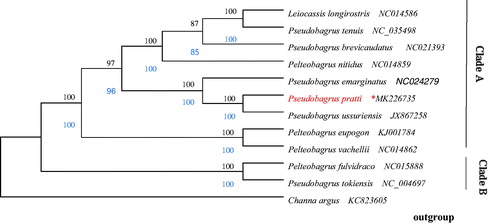Abstract
Pseudobagrus pratti is a unique freshwater fish and mainly distributed in the Yangtze River and Pearl River systems. In this study, the complete mitochondrial genome of P. pratti was first determined. The total length of the complete mitochondrial genome is 16,533 bp, contained 13 protein-coding genes (PCGs), two rRNA genes, 22 tRNA genes, one D-loop locus, and an origin of replication on the light-strand (OL). The overall nucleotide composition was 31.55% A, 26.76% T, 26.78% C, 14.91% G, with 58.31% AT, respectively. Phylogenetic analysis both highly supported that P. pratti showed a close relationship with P. ussuriensis and P. emarginatus. These data would contribute to elucidate the evolutionary mechanisms and biogeography of Pseudobagrus and is useful for the conservation of genetics and stock evaluation for P. pratti.
Pseudobagrus pratti (Osteichthyes, Siluriformes, Bagridae, Pseudobagrus) is a medium-sized freshwater fish, which mainly distributed in the Yangtze River and Pearl River systems (Cheng and Zheng Citation1987). This fish is an important economic fish, but study on mitochondrial gene sequencing of the fish has not been reported. In this study, the complete mitochondrial DNA sequence was first determined using the next generation sequencing (NGS).
The specimens were obtained from Neijiang, Sichuan Province of China (29°57″61.90″N, 105°06′01.70″E) in July 2018 and were stored in Zoological Specimen Museum of Neijiang Normal University (accession number: 20180724BB05). A 30–40 mg fins clip was collected and preserved in 95% ethanol at 4 °C. Total genomic DNA was extracted with a Tissue DNA Kit (OMEGA E.Z.N.A., Norcross, GA) following the manufacturer’s protocol. Subsequently, the genomic DNA was sequenced using the NGS, and then the mitogenome was assembled using P. ussuriensis as reference.
The complete mitochondrial genome of P. pratti was a circular molecule with 16,533 bp in length (GenBank Accession number MK226735). It is composed of 13 protein-coding genes (PCGs), 22 transfer RNA (tRNA) genes, two ribosomal RNA (rRNA) genes, and two non-coding regions: origin of light-strand replication (OL) and a D-loop control region. The total nucleotides composition of the P. pratt mtDNA was 31.55% A, 26.76% C, 26.78% T, 14.91% G, with 58.31% A + T, which was basically consistent with those of other teleost species (Pan et al. Citation2015). All PCGs initiation codons were ATG, except for COI that began with GTG. Correspondingly, five PCGs terminated with TAA codon, except four genes (COII, COIII, ND4, and ND6) ended with incomplete codon (T––) and four genes (ND1, ND2, ND3, and ND5) used TAG as stop codon, which was a little different from P. ussuriensis (ND3 with T––, ND5 with TAG, ND6 with TAA, Cytb with T––) and P. emarginatus (ND1 with TAA, ND2 with T––, ATP6 with TA––, ND3 with T––, ND5 and ND6 with TAA, Cytb with T––) (Wan et al. Citation2013; Shao et al. Citation2016). Moreover, the 22 tRNA genes ranged in size from 67 bp (tRNACys) to 75 bp (tRNALeu). Additionally, the 12S rRNA gene (955 bp) and 16S rRNA gene (1680 bp) were located between the tRNAPhe and tRNALeu genes and separated by the tRNAVal gene. Furthermore, the D-loop (890 bp) was located between tRNAPro and tRNAPhe.
So far, the mitochondrial genes have been widely used for inferring phylogenetic relationships (Boore et al. Citation2005). To confirm the phylogenetic relationships between P. pratti and other Bagridae subfamily fishes, phylogenetic analysis were performed on the concatenated dataset of 13 PCGs at nucleotide level with neighbour–joining (NJ) and maximum likelihood (ML) methods (Zhao et al. Citation2016; Zou et al. Citation2017). The tree topologies produced using NJ had nearly a same topology as that of ML tree (). Channa argus (Channoidei, Channidae) was defined as an outgroup. The other 11 species were divided into two clades. P. fulvidraco and P. tokiensis were clustered into clade B, and the rest of species were clustered into clade A. P. pratti, P. sussuriensis, and P. emarginatus were grouped in one clade, suggested the close relationship of these species, and further confirmed that P. pratti belongs to the subfamily Bagridae. In addition, two topologies all showed P. pratti, P. sussuriensis and P. emarginatus had a close relationship, which indicated that the rate of evolution of these three species was roughly equivalent.
Figure 1. The phylogenetic analyses of Pseudobagrus based on 12 protein-coding genes, constructed using the Neighbor-Joining (NJ) and Maximum Likelihood (ML). NJ posterior probabilities (blue number) and ML bootstrap values (black number) are shown at nodes.

In summary, the complete mitochondrial genome of P. pratti was first determined in present study. It was 16,533 bp long and showed a typical teleost mtgenome order. Phylogenetic analyses indicated that P. pratti showed a close relationship with P. sussuriensis and P. emarginatus. These data would contribute to elucidate the evolutionary mechanisms and biogeography of Pseudobagrus and is useful for the conservation of genetics and stock evaluation for P. pratti.
Disclosure statement
No potential conflict of interest was reported by the authors.
Additional information
Funding
References
- Boore JL, Macey JR, Medina M. 2005. Sequencing and comparing whole mitochondrial genomes of animals. Methods Enzymol. 19:311–348.
- Cheng QT, Zheng BS. 1987. Fish system search in China. Beijing: Science Press; p. 213–217 (in Chinese).
- Pan DD, Wei M, Wan Q, Tao G, Ma ZH, Wang H. 2015. The complete mitochondrial genome of Pseudobagrus trilineatus (Siluriformes: Bagridae). Mitochondrial DNA. 26:893–894.
- Shao K, Yan SX, Zhu B, Xiong MH, Tian H, Liao XL. 2016. The complete mitochondrial genome of Pseudobagrus emarginatus (Siluriformes: Bagridae). Mitochondrial DNA A DNA Mapp Seq Anal. 27:639–640.
- Wan Q, Tao G, Tao G, Cheng QQ, Chen Y, Qiao HY. 2013. The complete mitochondrial genome sequence of Pseudobagrus ussuriensis (Siluriformes: Bagridae). Mitochondrial DNA. 24:333–335.
- Zhao HP, Yuan DY, Luo W. 2016. The comparison of two complete mitochondrial genomes of Pseudobagrus ondon (Siluriformes, Bagridae). Mitochondrial DNA. 27:1267–1268.
- Zou YC, Xie BW, Qin CJ, Wang YM, Yuan DY, Li R, Wen ZY. 2017. The complete mitochondrial genome of a threatened loach (Sinibotia reevesae) and its phylogeny. Genes Genom. 39:767–778.
